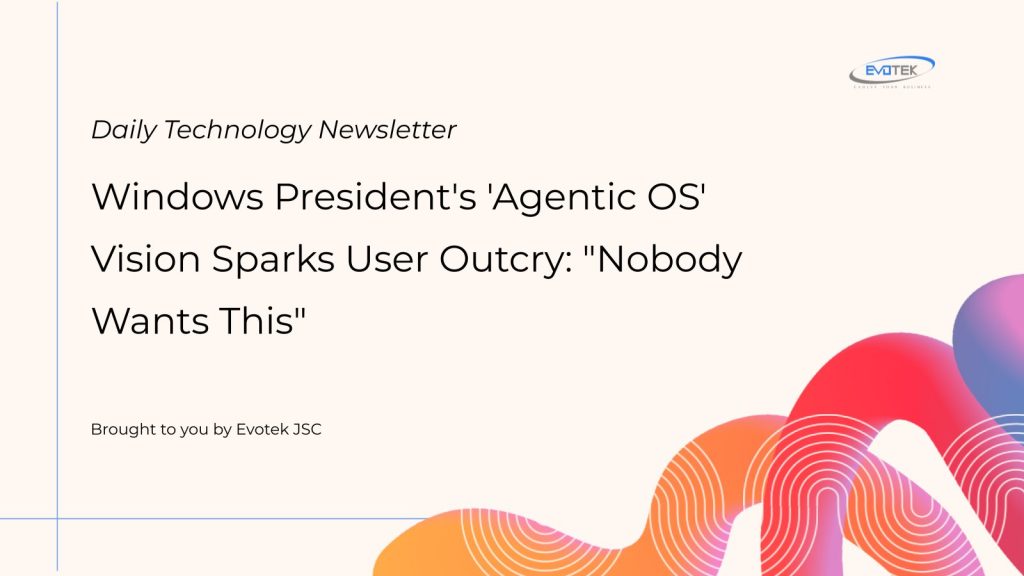Microsoft’s head of Windows, Pavan Davuluri, recently stirred a hornet’s nest with a statement on X (formerly Twitter), declaring that the platform is “evolving into an agentic OS.” This vision, which aligns with Microsoft’s internal reorganization to prioritize AI integration within Windows, has been met with significant and overwhelmingly negative pushback from the online community.
Microsoft’s Agentic OS Vision and User Resistance
Davuluri’s post, while framed around Microsoft Ignite and Windows’ role as an AI platform, reaffirmed the company’s commitment to transforming Windows into an “agentic OS.” This concept, teased repeatedly by Microsoft, points to a future where artificial intelligence takes a more autonomous and proactive role within the operating system.
However, the public’s reaction has been swift and critical. Replies to Davuluri’s tweet and discussions across various platforms reveal a strong consensus against an AI-first Windows. Comments such as “Stop this non-sense. No one wants this” and “Bro, straight up, nobody wants this” are indicative of the prevailing sentiment. This isn’t merely a small, vocal minority; widespread negative feedback consistently accompanies any news regarding Microsoft’s AI-centric future for Windows.
One X user bluntly questioned, “You are getting overwhelmingly negative feedback about all this AI stuff. And yet you persevere. Why?” This highlights a growing disconnect between Microsoft’s strategic direction and its user base’s desires.
Beyond AI: Windows’ Mounting User Experience Challenges
The resistance to an “agentic OS” is exacerbated by broader frustrations with the current state of Windows. Many users feel that the operating system’s reputation is at an all-time low. Instead of being a seamless platform that “gets out of the way,” Windows has been perceived as increasingly intrusive and “enshittified.”
- Forced Microsoft Accounts: The mandatory online account setup for Windows 11 is a frequent point of contention.
- Aggressive Service Promotion: Users report feeling pressured to use OneDrive and Copilot, often viewing these pushes as Microsoft attempting to extract more value from a product that isn’t free.
- Stability Issues: Despite extensive preview programs, Windows updates are often criticized for introducing new bugs and instability. One user lamented, “It’s evolving into a bug-ridden slop pile… You guys have utterly destroyed what was already a heavily flawed product in the first place.”
Users argue that Microsoft should focus on perfecting the fundamentals of the operating system before attempting to integrate complex AI functionalities throughout.
The Cost of an AI-First Obsession
Microsoft’s aggressive pivot towards AI has reportedly come at a cost to other divisions. Significant budget cuts have been observed across areas like Xbox and Surface, leading to concerns that core product quality is suffering as the company funnels resources into AI projects and infrastructure. The perception among many is that for Microsoft, if it’s not AI, it’s not a priority.
This single-minded pursuit of AI, coupled with a decade of what many perceive as letting customers down through cancelled products and features, has created a formidable challenge for Microsoft. Users are hesitant to embrace Copilot, OneDrive, or a mandatory Microsoft account when trust has been eroded. Had Microsoft prioritized consumer appeal and user care over the last ten years, the company might not need to resort to what some consider “dirty tactics” and “hostile user experience design” to push its services.
Ultimately, a significant shift in strategy is required. Microsoft must address the “enshittification” of Windows, ease its aggressive AI pedal, and recommit to delivering a stable, user-centric operating system. Only then might it begin to rebuild the trust necessary for users to willingly engage with its ecosystem.
Fun fact: Windows 11 stands out as the only major modern operating system that mandates an online account during setup. Competitors like Android, iOS, iPadOS, macOS, Linux distributions, and even Chrome OS all offer users the option of a local account. This underscores the extent of Microsoft’s current approach to user onboarding.

 日本語
日本語 한국어
한국어 Tiếng Việt
Tiếng Việt 简体中文
简体中文